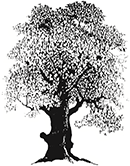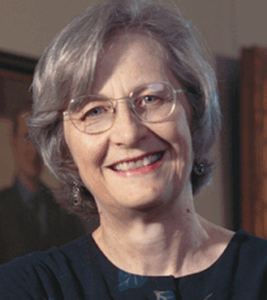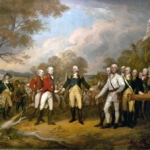Up and Down the Kennebec Valley: Women: Ballard – Part 2
by Mary Grow
Martha (Moore) Ballard (1735 – 1812), to whom readers were introduced last week, cannot be considered a “typical” housewife, because she was a practicing midwife, out of the house on business much of the time. A housewife she undoubtedly was, however, maintaining a home for her husband, surveyor Ephraim Ballard, whose job was often more time-consuming than hers, and six of the nine children she bore between 1756 and 1779 (three died in a 1769 diphtheria epidemic).
Martha was atypical in another way: if any of the women around her kept daily diaries, they have not survived. Martha kept a diary from Jan. 1, 1785, until shortly before her death in May 1812. Historian Laurel Thatcher Ulrich used it as the basis for her unusual book on women’s lives in 1800s Maine, A Midwife’s Tale, published in 1990.
Last week’s article, based mostly on Ulrich’s history, talked about two kinds of household duties: washing and cleaning, and working with cloth. The latter, in Martha’s time, started with growing some of the materials (flax, for example). Then women made them usable as cloth, wool and the like and wove, sewed or knitted them into household necessities and clothing.
Two other categories of housework will be explored this week, cooking and gardening (the latter defined broadly to include the livestock in the Ballards’ lives).
* * * * * *
When the Ballards moved into their first Hallowell house in 1778, Ulrich said there were seven of them, the parents and five children, Cyrus, Jonathan, Hannah, Dorothy (Dolly) and Ephraim, Jr. Oldest daughter Lucy Towne was living in Winslow with her husband. The diary records visitors almost daily, often for a meal, sometimes overnight.
Despite the number of mouths to feed, Martha said very little about preparing meals in the diary entries that Ulrich chose to copy. Once or twice she commented that “We brewed,” without specifying whether she meant beer, tea, coffee, or something more unusual.
An example: on Oct. 7, 1789, she recorded that a female visitor “dind” (dined), and later two men “drank tea” (one of them had brought her a barrel of smoked herring three days earlier, whether as a gift or a payment she did not say). Presumably Martha or her daughters fixed lunch and made – or “brewed” – tea.
Four days later, on Oct. 11, she wrote that “We had Chickens for dinner.” No information on who cooked them or how, or even whose chickens they were.
In the fall of 1792, there were two weddings in the Ballards’ house. On Oct. 28, Hannah married Moses Pollard; on Nov. 18, Martha’s niece, Parthenia Barton, married Shubael Pitts. Martha said nothing about food on either occasion.
She only occasionally mentioned cooking equipment. On Nov. 2, 1792, after visiting two women whose babies she had recently delivered (both were doing well, or “description,” to use her favorite adjective), she bought from the store run by one of the husbands two iron kettles, one spider, two pepper boxes and two “dippirs.” (Whether “spider” meant a frying pan or a skimmer, your writer does not know.)
On Nov. 14, she was back in the store, spending a fee she had just received for a January delivery on two “puter” (pewter) dishes, a coffee pot and half a dozen tablespoons.
When Martha did mention cooking, she omitted details, at least in most of the couple hundred diary entries Ulrich chose.
For example, on Jan. 3, 1796, Martha had been with a woman who was apparently ill, not pregnant (there is no record of a birth) since the evening of Jan. 1. She came home about 11 a.m. and “Bakt and Cleand my hous and did other matters.”
On Jan. 17 that year, Martha fed husband Ephraim, daughter Dolly and her husband, Barnabas Lambard, and four other people “roast Chickins” before she was called out overnight waiting for a birth.
The next day, Martha delivered two baby boys, one at 11 a.m. and another at 4:30 p.m., each his mother’s first child. When she got home at 8 p.m., Martha recorded that her brother Ebenezer was staying overnight.
“I made Bids, washt dishes, swept house, and got supper. I feel some fatagud [fatigued],” she wrote.
Toward the end of the month, she recorded one day feeling so sick that she resented the “nesescity” of fixing breakfast for her husband and son Cyrus. Later, though, Cyrus brought home a young friend, and with her help, Martha found the energy to make “chicken, minc, apple and pumpkin” pies and some “flower bread.”
On a snowy Feb. 7, 1801, Martha wrote that she stayed home and “We [unspecified] bakt and Churned 7 lb 14 oz. butter.” Ephraim, son Cyrus, son-in-law Moses Pollard and Dr. Daniel Cony were also at the house at least part of that day.
In May 1809, while very busy planting a garden and doing other outdoor chores, as well as housework, Martha found time to write that she “Bakt brown Bread.”
She occasionally recorded a meal she did not cook. On Nov. 18, 1793, in a rainstorm that ended as snow, she went to “Capt Meloys,” where his “Lady” gave birth to a “fine daughter” a little after 8 p.m. Martha shared an “Elligant supper” with the other attendants, spent the night and the next day got paid on the spot and “returnd home after dineing.”
* * * * * *
The Ballard house was surrounded by gardens, and the family had livestock. Gardening was primarily women’s work in the early 1800s (perhaps because the menfolk had too much else to do), and the domestic animals and birds were at least partly the housewife’s responsibility, too.
Among the Ballards’ domestic animals were horses, oxen, cows, swine (also referred to as pigs or hogs), sometimes sheep, turkeys and chickens.
Chickens, turkeys, cows and at least one horse seem to have been around all the time. Martha intermittently mentioned eating chicken or turkey; killing turkeys and stripping turkey feathers; cows’ health; and using her husband’s horse to get to a patient’s house.
Ulrich commented on Martha’s preoccupation with her turkeys in the spring of 1792. One was nesting on April 7; in May, Martha repeatedly recorded putting eggs under nesting birds. On May 26, the black turkey hatched 14 chicks, and by June 2, there were 42, followed by 14 more in mid-August – “not long,” Ulrich commented, “before the first of the spring brood was ready for the table.”
Sheep were not always part of the farm. Ulrich quoted a Dec. 8, 1790, entry in which Martha noted their four new sheep were “the first we have ownd this 14 years.” By the spring of 1804, they had more than 20.
Gardening references were not always in the spring and summer: on Oct. 4, 1789, Martha picked green peas from the garden, and on Dec. 17, 1800, she had fresh green parsley to add to her gravy.
To support her professional work, Martha raised what Ulrich called “remedies from the earth,” medicinal plants like anise (used as a laxative), camomile, coriander, hyssop, marigolds (especially for skin conditions, WebMD says), mint (Healthline says mint helps with digestion and may relieve breastfeeding pain), mustard, parsley, saffron (used, Ulrich said, “to treat jaundice in newborn children”) and sage.
In addition to growing herbs, Martha and her helpers gathered native plants to use as medicine. Ulrich mentioned burdock, comfrey, sweet clover and Solomon’s seal, among others.
Outdoor work came into prominence in the spring of 1791, after the Ballards moved to a different house in April. (They moved again in December 1799, to son Jonathan’s farm on the northern edge of Augusta.) A combination of diary excerpts and Ulrich’s summaries showed the complications of starting a new garden.
The family completed their 1791 move on April 21, and on April 22 Martha wrote, “At home. Began my gardin.”
First, Ephraim had to plow a piece of land; then, Martha wrote, she dug out and raked away grass roots. Ulrich reported bean, pea and corn plants by mid-May, and “beet greens for dinner.” On Aug. 23, Martha picked a ripe watermelon.
The “old cow,” driven to her new property by the Ephraims, father and son, had a calf on May 3, but the calf soon died. A hen lost 11 of her 16 chickens before young Ephraim brought her to the new house.
The diary has occasional references to Martha treating the animals. It was probably in the spring of 1794 that a lamb was born “with the Entrales all out”; Martha stuffed them back in, sewed up the wound and wrote that the lamb “suckt & walkt afterwards.” In November, 1795, she mentioned “Nursing my Cow,” whose “Bag is amazeingly Sweld.”
In the spring of 1809, Martha – then 74 years old – recorded her early gardening in detail, amid reports of visits to family and friends, housework and midwifery.
On May 9, she “sett Turnips & Cabbage stumps.” (Ulrich explained cabbage stumps as roots of the previous year’s cabbage, over-wintered in the cellar.) On May 10, she started removing the winter banking from the house foundation and planted cucumbers and three kinds of squash; on the 12th, she planted more squash and cucumbers.
On May 13, Martha took off more banking and planted more squash. It rained on May 14; on May 15, despite afternoon showers, Martha “dug ground” west of the house and on the east side planted “squash, Cucumbers, musk and water mellons.” Meanwhile, Ephraim (who was 84) and their son Jonathan ploughed “our field.”
May 17 was a warm, spring-like day. Martha “Planted long squash by the hogg pen, sowd pepper grass, sett sage and other roots,” while her husband “mode Bush & dug gardin.”
The next day, Ephraim continued digging the garden and set hop poles (hops are usually associated with beer, but Wikipedia says they are used in herbal medicine, too), while Martha “Sett Parsley & 3 quins trees by the pigg pen.” She also had currant bushes, gooseberries, and apple, cherry and plum trees.
On May 19 and 20, Martha “workt in gardin,” without details.
From May 22 through May 31, Martha recorded something about her garden work all but three days. One of those days she delivered James Caton’s wife’s eleventh child and fifth son. The other two, she was busy delivering her daughter Hannah Pollard’s ninth child and sixth daughter, who weighed 11 pounds.
Between births, she “sett” two more “quins” trees and an apple tree; planted potatoes; set “Leutis plants” (lettuce, perhaps?) and strawberries; sowed string peas (Wikipedia seems to think these are snap peas) and the next day, “pees &c”; planted “Crambury, Brown, & hundred to one beens south of the house”; transplanted cucumbers (the cucumbers and squash east of the house were up by May 22); and “sett” squash and cucumber plants.
Elsewhere, with a footnote referring to a June 1808, entry, Ulrich explained that Martha started many of her plants in raised beds “on the sunny side of the house” and moved them to the main garden after the ground warmed up. She credited Martha with soil improvements, like adding manure, some brought from behind the outhouse.
Produce must have been preserved in various ways for winter and spring eating, but this work is seldom described in the diary entries Ulrich transcribed. One fall 1809 entry refers to making pickles and putting cider in the cellar.
On May 25, 1809, Martha fell off her horse as she came home from the Catons’. By early June, Ulrich wrote, she had a sore and swollen left knee, either from the fall or from “the continued exertions of the garden,” that was keeping her awake at night.
Ulrich quoted the June 9, 1809, diary: “I am still lame but have workt in my gardin all day.”
Quince trees still grown in Maine
Quince trees still grow in Maine, according to Roberta Bailey, of Seven Tree Farm, in Vassalboro, author of an article on the Maine Organic Farmers and Gardners (MOFGA) website. Bailey wrote that the fruit originated in western Asia, east of the Mediterranean, some 4,000 years ago. Brought to the Americas by European settlers, in New England especially it was popular in home gardens and commercially. One use was making quince cheese, by boiling quince fruit “all day until it was thick like cheese.”
Main sources
Ulrich, Laurel Thatcher, A Midwife’s Tale The Life of Martha Ballard, Based on Her Diary, 1785-1812 1990
Websites, miscellaneous.
Responsible journalism is hard work!
It is also expensive!
If you enjoy reading The Town Line and the good news we bring you each week, would you consider a donation to help us continue the work we’re doing?
The Town Line is a 501(c)(3) nonprofit private foundation, and all donations are tax deductible under the Internal Revenue Service code.
To help, please visit our online donation page or mail a check payable to The Town Line, PO Box 89, South China, ME 04358. Your contribution is appreciated!







Leave a Reply
Want to join the discussion?Feel free to contribute!